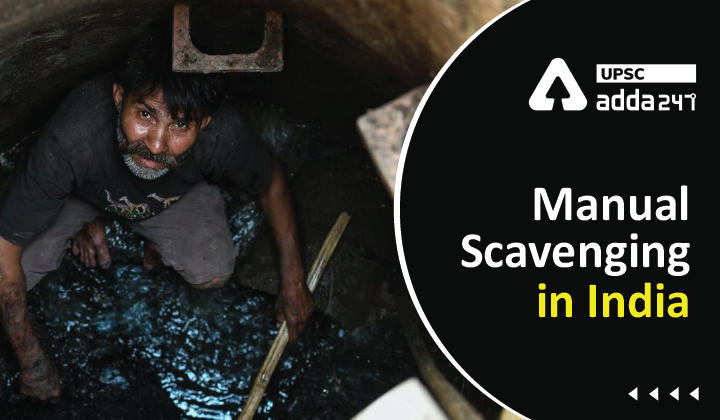Table of Contents
Manual Scavenging in India- Relevance for UPSC Exam
- GS Paper 2: Governance, Administration and Challenges- Welfare schemes for vulnerable sections of the population by the Centre and States and the performance of these schemes.
Manual Scavenging in India in news
- Three labourers in Mumbai allegedly hired for manual scavenging, died recently after inhaling toxic fumes in a septic tank.
What is Manual Scavenging?
- Manual scavenging is the practice of physically removing human excreta by hand from sewers or septic tanks. This dehumanizing practice is mostly undertaken by members of the Dalit community, which is at the bottom of India’s caste system.
- According to the PEMSR 2013 Act, the definition of manual scavengers was broadened to include people employed to clean septic tanks, ditches or railway tracks.
Ban on Manual Scavenging in India
- Under the Prohibition of Employment as Manual Scavengers and their Rehabilitation Act, 2013, Manual Scavenging practice is banned in India.
- The Prohibition of Employment as Manual Scavengers and their Rehabilitation Act, 2013 prohibits the employment of manual scavengers, the manual cleaning of sewers and septic tanks without protective equipment.
- It also bans the construction of insanitary latrines.
Key Features of The Prohibition of Employment as Manual Scavengers and their Rehabilitation Act, 2013
- Prohibition: The Act prohibits the employment of manual scavengers, the manual cleaning of sewers and septic tanks without protective equipment, and the construction of insanitary latrines.
- Rehabilitation: It seeks to rehabilitate manual scavengers and provide for their alternative employment.
- Monitoring and Construction of Sanitary latrines: Each local authority, cantonment board and railway authority is responsible for surveying insanitary latrines within its jurisdiction.
- They shall also construct a number of sanitary community latrines.
- Responsibility of the People: Each occupier of insanitary latrines shall be responsible for converting or demolishing the latrine at his own cost.
- If he fails to do so, the local authority shall convert the latrine and recover the cost from him.
- Implementing Authorities: The District Magistrate and the local authority shall be the implementing authorities.
- Punishment for Violation: Offences under the Act shall be cognizable and non-bailable, and maybe tried summarily.
Why Manual Scavenging in India is still Prevalent?
- Poor Implementation: PEMSR 2013 Act is poorly implemented on the ground. This results in the exploitation of the poor who are unable to protect themselves against such ghastly practices.
- Availability of Cheap Labour: This is often exploited by the contractors as there is a lot of cheap, unskilled labour is available to them.
- So, contractors illegally employ them at a very poor daily wage. They often get away with this because of corruption and poor implementation of the Act.
- Lack of Awareness: Government is also not doing enough to generate adequate awareness among common people, especially among the victims of Manual scavenging about various harmful health effects of such practices.
National Commission for Safai Karamcharis





 TSPSC Group 1 Question Paper 2024, Downl...
TSPSC Group 1 Question Paper 2024, Downl...
 TSPSC Group 1 Answer key 2024 Out, Downl...
TSPSC Group 1 Answer key 2024 Out, Downl...
 UPSC Prelims 2024 Question Paper, Downlo...
UPSC Prelims 2024 Question Paper, Downlo...
